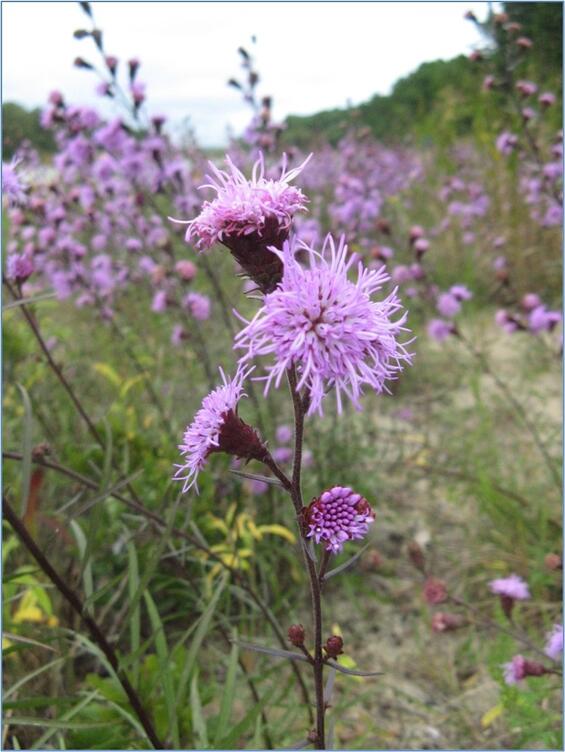- Scientific name: Liatris novae-angliae (Lunell) Shinners
- Species of Greatest Conservation Need (MA State Wildlife Action Plan)
- Special Concern (MA Endangered Species Act)
Description

Photo credit: Jennifer Garrett, NHESP
New England blazing star (Liatris novae-angliae) is an endemic, globally rare perennial in the aster family (Asteraceae), found in dry, sandy grasslands and clearings. It features showy purple flowers that bloom from late August to October.
New England blazing star grows up to 80 cm (2.6 ft) tall and has numerous alternate, entire, hairless, and very narrow stem leaves ranging from 1-2.5 cm (0.4-1 in) wide. The plant bears 3 to 30 hemispheric purple flower heads, each composed of 20 to 80 individual flowers. The flower heads are borne on stalks (peduncles) that range from very short (subsessile) to up to 5 cm (2 in) long.
New England blazing star is the only native Liatris species in Massachusetts. Two non-native species, gayfeather (L. pycnostachya) and dense blazing star (L. spicata), resemble it somewhat but differ in that their flower heads are sessile, more cylindrical, and contain far fewer flowers (5-14 per head). Knapweeds (Centaurea spp.) can sometimes be confused with blazing star but typically have brown or black fringed involucral bracts and lobed or toothed leaves.
Life cycle and behavior
This is a perennial species. It flowers from mid-August through mid-October, and is pollinated by a variety of insects. Its seeds are wind-dispersed as are most seeds in aster family plants.

Population status
Listed as special concern under the Massachusetts Endangered Species Act, New England blazing star is currently found in Barnstable, Dukes, Essex, Franklin, Hampden, Hampshire, Middlesex, Nantucket, Plymouth, and Worcester Counties. It is historically known from Bristol, Norfolk, and Suffolk Counties. All listed species are legally protected from harm and habitat destruction.
Distribution and abundance
New England blazing star is endemic to the northeastern United States, found in Connecticut, Maine, Massachusetts, New Hampshire, New York, Pennsylvania, and Rhode Island. It is rare throughout its range and presumed extirpated from New Jersey.

Distribution in Massachusetts. 2000-2025. Based on records in the Natural Heritage Database.
Habitat
New England blazing star inhabits open, dry, nutrient-poor sandy soils in grasslands, heathlands, and barrens. It thrives in fire-influenced natural communities with periodic disturbance and little woody cover. Associated species include bearberry (Arctostaphylos uva-ursi), huckleberries (Gaylussacia spp.), blueberries (Vaccinium spp.), scrub oak (Quercus ilicifolia), bayberry (Morella pensylvanica), little bluestem (Schizachyrium scoparium), wavy hair-grass (Deschampsia flexuosa), Pennsylvania sedge (Carex pensylvanica), and butterfly weed (Asclepias tuberosa).
Healthy habitats are vital for supporting native wildlife and plants. Explore habitats and learn about conservation and restoration in Massachusetts.
Threats
Major threats include development, suppression of disturbance (leading to encroachment of woody vegetation), indiscriminate herbicide use, mowing during the growing season, deer browsing, and trampling. The accumulation of organic matter can degrade suitable habitat.
Conservation
Exact management needs are not fully known. Research indicates that populations increase with high-frequency fire disturbance, but mowing (conducted after the growing season, from November to April) can also maintain suitable habitat. Management actions should ensure that open, exposed soils are retained to support seed germination.
Sites should be monitored for over-shading due to succession, and for exotic species invasions, as these habitats are prone to colonization. Where recreation is a threat, trails may be stabilized or re-routed. All management within rare plant habitats should be planned with MassWildlife’s Natural Heritage & Endangered Species Program.
Contact
| Date published: | April 30, 2025 |
|---|